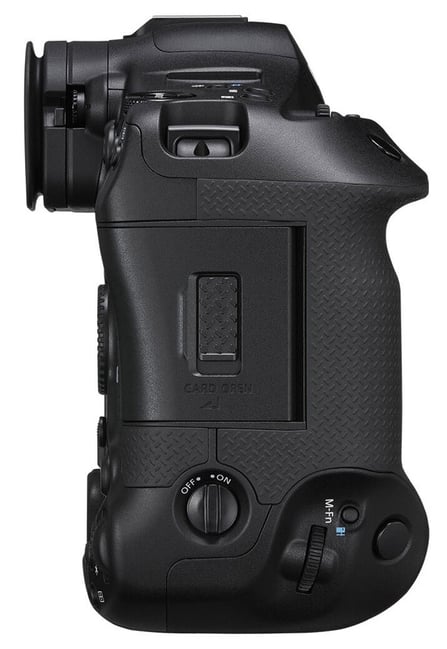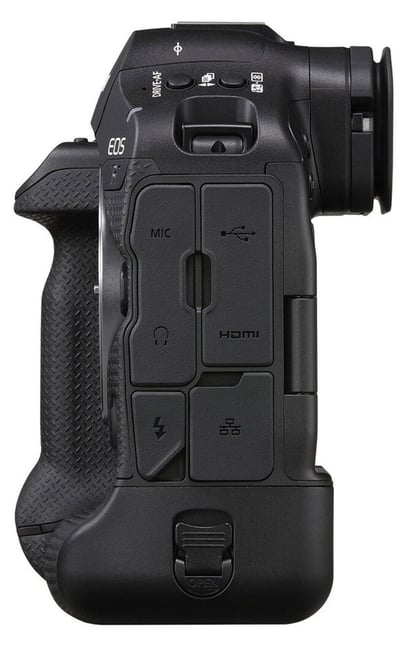Canon just announced their long-awaited EOS R1 flagship, an ultra-high-speed camera with an integrated grip and perhaps the best electronic viewfinder on the market. While the 24 megapixel sensor may be lower than some had hoped, this camera is otherwise the most advanced Canon camera we’ve seen yet.
Specifications
- Announced: July 2024
- Sensor Type: Stacked CMOS
- Processor: DIGIC X + Accelerator
- Megapixels: 24.0 (6000 x 4000 resolution)
- Sensor Dimensions: 36.0 x 24.0mm (Full Frame)
- Pixel Size: 6.0µ
- Anti-Aliasing Filter: Yes
- In-Body Image Stabilization: Yes
- ISO Range: 100-102,400
- Expanded ISO Range: 50-409,600
- High-Resolution Sensor Shift: No
- Focus Bracketing: Yes
- Pre-Release Burst: Yes (raw)
- Shutter Speed Range: 1/64,000-30 seconds
- Frame Rate: 12 FPS (mechanical), 40 FPS (electronic)
- Buffer (Lossless Raw): Over 1000 frames (40 FPS)
- Autofocus System: Hybrid PDAF with 1053 auto-selectable points
- Eye-Controlled Autofocus: Yes
- Low-Light AF Sensitivity (f/2 Standardized): -6 EV
- Flash Sync Speed: 1/320 (EFCS), 1/200 (mechanical shutter)
- Sensor Protection Curtain: Yes
- Max Video Recording: 6K 60p raw
- 4K Maximum Framerate: 120 FPS
- 1080p Maximum Framerate: 240 FPS
- Card Slot 1: CFExpress Type B
- Card Slot 2:CFExpress Type B
- Rear LCD: 3.2″ 2.1 million dot fully articulating touchscreen
- Electronic Viewfinder: 0.90x magnification, 9.44 million dots
- Bluetooth: Yes
- WiFi: Yes
- USB: Type C 3.2 Gen 2
- Battery: LP-E19
- Weight (Body Only w/ Battery + Card): 1115 g (2.46 lbs)
- Dimensions (LxHxD): 158 x 150 x 107 mm (6.2 x 5.9 x 3.4″)
- MSRP: $6300 (check availability at B&H)
- Shipping: November 26, 2024
Deliberately or not, Canon let a lot of anticipation build for the EOS R1 over the years. In their DSLR days, the “1D” line was reserved for their fastest, most capable flagship cameras, and their approach to naming mirrorless cameras has been pretty similar. The lower the model number, the more advanced the camera in Canon’s world. So whatever camera took the number 1 was sure to be impressive.
And looking at the specs above, there’s a lot to like. The camera can shoot 40 FPS bursts – practically slow-motion video, but stills – for over 1000 frames. It also allows up to half a second of pre-release buffering capabilities, and the autofocus system promises to be Canon’s most advanced yet. Borrowing from the eye-sensing viewfinder of the EOS R3 (and improving its accuracy), focus acquisition should be a breeze. The result is an extremely capable camera that shouldn’t falter with any subject.
But there is one specification that’s going to cause some people concern, and that’s the 24 megapixel sensor. Some photographers had been hoping for a 45 megapixel sensor, basically combining the best of the Canon EOS R5 and the EOS R3 into one camera. That’s not what we got. Instead, Canon has maximized the camera’s speed under the assumption that 24 megapixels is enough for the professional sport, event, and broadcast photographers who are the camera’s primary audience.
I think that Canon is largely correct about that – 24 megapixels is plenty for most applications – but there’s also the question of optics (and I don’t mean lenses). With Nikon’s Z9 at 45 megapixels and Sony’s a1 at 50 megapixels, Canon did leave the door open to some criticism that their flagship is not at the same level. I tend to think that the EOS R5 Mark II, also announced today, is enough to fill that gap for Canon, but I’m not sure if that’s how every photographer will see it.
In any case, the Canon EOS R1 looks to be a seriously capable machine. It’s a meaningful upgrade over the EOS R3, even before you consider that Canon has improved the speed and capabilities of their autofocus algorithms with the help of the new DIGIC Accelerator chip. The price of $6300 is high, but for the professionals and organizations who Canon is targeting, it will be an easy decision to get.
Pre-Order
You can support Photography Life by pre-ordering the Canon EOS R1, or buying any other photography gear, through our affiliate links to B&H.
Thank you for supporting our site! Note that in the case of the Canon EOS R1, not all the specifications are publicly available yet. We will bring you information on battery life and other missing information as soon as we learn it.
Press Release
Canon Officially Launches the New EOS R1 and EOS R5 Mark II Full-Frame Mirrorless Cameras
MELVILLE, N.Y., July 17, 2024 — Canon U.S.A., Inc., a leader in digital imaging solutions, today launched two new professional full-frame mirrorless cameras, the EOS R1 and EOS R5 Mark II. The EOS R1 camera is designed for both professional still photographers and video creators in a wide range of fields including sports, news reporting and high-end video production. The EOS R5 Mark II camera features improved video focused features for the advanced creators and real-time multi recognition tracking system for those who focus on still photography.
Canon EOS R1 Camera is “Ahead of the Game”
Canon’s EOS 1-series legacy continues with the unveiling of the flagship EOS R1 camera. This high-performance, reliable, and weather-resistance camera is designed for professionals in the photojournalism, sports and wildlife fields. Key features of the EOS R1 camera include:
- Back-illuminated stacked 24.2 megapixel full-frame sensor and new processing system for extremely fast reading
- Increased read-out speed, reducing “rolling shutter” distortions
- Still-image shooting speeds up to 40fps
- “Cross-type AF” imaging sensor for more positive focus on subjects with linear detail
- Strong video capabilities, up to 4K (also 6K RAW video options)
Canon EOS R5 Mark II Camera helps users “Master the Moment”
For the professional who demands high-quality still and video output, the EOS R5 Mark II camera is ready to deliver. Designed with performance and image quality at its core, the EOS R5 Mark II camera offers the fundamental elements in one package for sports/wildlife photographers, journalists/producers, video producers and visual creators. Key features of the EOS R5 Mark II camera include:
- Back-illuminated stacked 45 megapixel full-frame sensor and new processing system for extremely fast reading
- When compared to previous EOS R camera models, more advanced and powerful AF system including Eye Control AF and new subject tracking technologies
- Cinema EOS video features such as:
- Custom Picture color profile including Canon Log 2
- False Color Wave Form Monitor
- 4CH Audio with 24bit LPCM
- Pre-recording up to 5 seconds
Accessories for the EOS R5 Mark II camera were designed thoughtfully with the end-user in mind. There is a new, more powerful battery. The LP-E6P battery, when compared to previous battery versions, features higher continuous power and two-times the amperage. Optional battery grips were also thoughtfully designed, and there are three options:
- BG-R20– For vertical operability
- BG-R20EP with Ethernet – Port enables high-speed wired communication
- CF-R20EP with Cooling Fan and Ethernet – Cooling fan helps maximize movie performance
Both cameras feature the new DIGIC Accelerator, which is an addition to the DIGIC X processor. The DIGIC Accelerator assists with deep learning processing which helps to quickly analyze large volumes of data and supports the next-gen AF system, Dual Pixel Intelligent AF. Dual Pixel Intelligent AF is based on Accelerated Capture and deep learning, allowing end-users to experience tracking advancements, such as body, joint and head area estimation and focus on people other than the main subject.
Price and Availability
The Canon EOS R1 camera is expected to be available in the Fall of 2024, for an estimated retail price of $6,299.00*. The Canon EOS R5 Mark II camera is expected to be available in August 2024, for an estimated retail price of $4,299.00* for the camera body only. The EOS R5 Mark II camera kit, which will include the RF24-105mm F4 L IS USM lens, will have an estimated retail price of $5,399.00*. The estimated retail prices for the optional battery grips are:
- BG-R20– $349.99*
- BG-R20EP – $499.99*
- CF-R20EP – $399.99*
For more information, please visit www.usa.canon.com.
About Canon U.S.A. Inc.
Canon U.S.A., Inc., is a leading provider of consumer, business-to-business, and industrial digital imaging solutions to the United States and to Latin America and the Caribbean markets. With approximately $29.4 billion in global revenue, its parent company, Canon Inc. as of 2023 has ranked in the top-five overall in U.S. patents granted for 38 consecutive years†. Canon U.S.A. is dedicated to its Kyosei philosophy of social and environmental responsibility. To learn more about Canon, visit us at www.usa.canon.com and connect with us on LinkedIn at https://www.linkedin.com/company/canonusa.
# # #
† Based on weekly patent counts issued by United States Patent and Trademark Office.
* Specifications, availability and prices are subject to change without notice. Actual prices are set by individual dealers and may vary.





I honestly wonder what Canon’s product development team were thinking when they decided to roll this out. It seems rushed and quite shockingly very underwhelming to say the least.
So. This failure.
The main and only competitor of this camera is the R3!
The A9iii is also 24 megapixels, but there is a global shutter and all its advantages.
A1, Z9 and Z8 have a higher resolution of the matrix and can shoot 8K.
Result. If Canon released it as an R3ii and priced at 5,000 bucks tax-free, I would praise it.
And so, fans of the brand will buy this camera, I doubt that this product will be able to take away many customers from Sony and Nikon.
In Nikon terminology, this is a R3s.